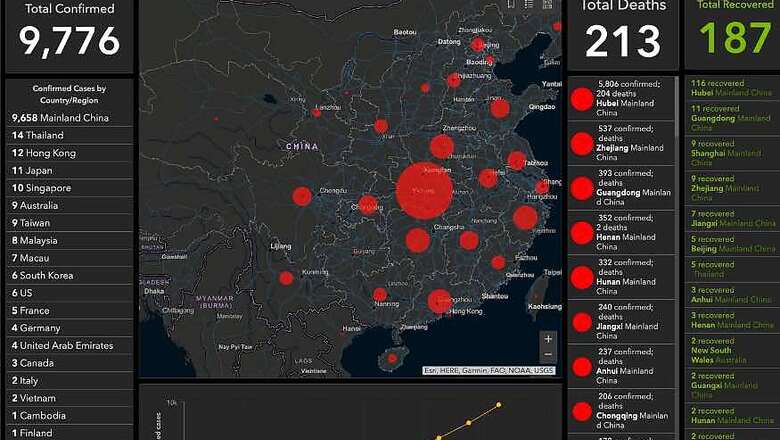
views
As the deadly Coronavirus is spreading around the world, the World Health Organization (WHO) have declared the ongoing Coronavirus outbreak a global health emergency. As many as 213 people have reportedly died in China and as many as 10,000 cases of Coronavirus infections are being treated. The WHO also confirmed that there have been as many as 98 reported cases in 18 countries globally. Health officials in Chicago, US, have confirmed the first US case of human-to-human transmission of the Coronavirus. The situation is bad, since the efforts to curb the spread of the Coronavirus have not yielded results that were perhaps expected, but the virus is also spreading globally. Researchers in the US have made a new real-time map (you can access it here) that tracks the global spread of the Coronavirus—you can access it here.
The Coronavirus first emerged in Wuhan, China, and there were fears from the outset that it could spread around the world as millions of people travel. This coincided with the Chinese New Year, which sees millions travel around the world, to and from China. This map has been developed by the Center for Systems Science and Engineering at the John Hopkins University in Baltimore. This map relies on data collected from the World Health Organization (WHO), Centers for Disease Control and Prevention (CDC), National Health Commission of the People's Republic of China (NHC) and Dingxiangyuan, which is an online medical community. This live map may be great news for travellers who could find this as a good reference point to check if they must go ahead with their journey or not.
The latest data suggests that 9,776 cases of Coronavirus infections have been confirmed globally. Of this, 9,568 are from Mainland China, 14 in Thailand, 12 in Hong Kong, 10 in Singapore and 9 in Taiwan. The cases of Coronavirus have also been confirmed in Malaysia (8), Macau (7), South Korea (6), US (6), France (5), Germany (4), UAE (4), Canada (3), Italy (2) and Vietnam (2). Cases have also been confirmed in Cambodia, Nepal, Philippines, India, Nepal and Sri Lanka. “Our greatest concern is the potential for the virus to spread to other countries with weaker health systems, which are ill prepared to deal with it,” said Tedros Adhanom, director general of the WHO, in an official statement.
Scientists believe that the Coronavirus, the 2019-nCoV as it is being called, enters the human body through the nose or mouth. It then finds a host cell in the respiratory system. the human to human transmissions of the virus has also been confirmed now. After some incubation period, the host cell disintegrates thereby spreading the virus to the nearby cells, thereby multiplying the infection inside the human body. Coronavirus belongs to a virus family known as Coronaviridae, which when looked at under the microscope, look like spiked rings. Once inside the human body, they multiply.
The CSSE documents that on Jan 13, Thailand reported the first international case outside China, while the first cases within China, but outside of Wuhan were reported on January 19—these were in Guangdong and Beijing. China’s National Health Commission (NHC) confirmed on January 20 that the coronavirus can be transmitted between humans, since the virus can be put back into the surroundings by a simple sneeze or cough.
The symptoms of the 2019-nCoV include runny nose, cough, sore throat and high temperature. It can also lead to pneumonia, an infection where the lungs fill up with fluid and can lead to death by ‘drowning’.
“Early on, many of the patients in the outbreak in Wuhan, China reportedly had some link to a large seafood and animal market, suggesting animal-to-person spread. However, a growing number of patients reportedly have not had exposure to animal markets, suggesting person-to-person spread is occurring. At this time, it’s unclear how easily or sustainably this virus is spreading between people,” says the CDC. Coronaviruses are common in many animals, and have also evolved forms that can infect humans too—two recent coronaviruses evolutions have resulted in the SARS outbreak in 2002 and the MERS outbreak in 2012.
The Pharmaceutical Technology reports that scientists at the National Institutes of Health (NIH) in the US are already working on a vaccine against the deadly coronavirus, but it could be almost an year before it becomes available. They are using the data from their understanding of the Severe Acute Respiratory Syndrome (SARS) virus for this vaccine. But clearly, this won’t come in time to help anyone unfortunately infected by the 2019-nCoV. SARS had infected more than 8000 people in Asia and killed more than 800 at the time.




















Comments
0 comment